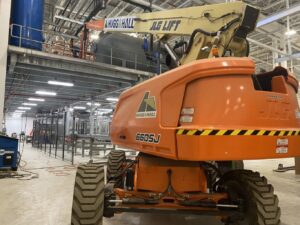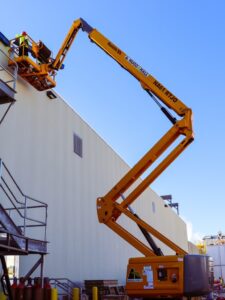
How to Avoid Common Construction Site Injuries
What’s new: OSHA reported that in 2022, there were 5,486 fatal construction site injuries in the US.
Why it matters: You can keep yourself, and your team, safer by knowing how to avoid common construction site injuries.
If you work with heavy machinery, you know how important safety is. According to the U.S. Bureau of Labor Statistics, jobs in construction, transportation, and warehousing were responsible for over 358,000 reported injuries in 2020. Many of these common jobsite injuries were preventable.
At Hugg & Hall, we want to make sure your jobsite is as safe as possible. We’ve created this post to teach everyone more about common workplace injuries and how to prevent them.
Collisions/Machinery Accidents
Material handling and light construction equipment is essential to most warehouses and jobsites, but these machines also cause thousands of accidents every year.
Even the most safety-conscious teams can experience a collision or machinery accident. It’s vital that your team stays alert and knows how to work safely.
Think your team could use a safety refresher course? Visit our training page to sign up.
Your team should always perform a pre-operation walkaround and maintain 3 points of contact when entering a machine.
Your operators should constantly be checking their blind spots to avoid crashing into another machine or an employee.
If you are using a piece of equipment to move heavy loads, like a forklift or telehandler, always ensure you’ve achieved proper load distribution. Uneven loads can cause the machine to tip.
Always follow OSHA, ANSI, and the manufacturer’s standards when operating a piece of machinery.
Proper action saves lives. Educate your team on how to avoid collisions and other accidents.
Slips, Trips, and Falls
Whether your employees work on a construction site or warehouse, slips and falls are a serious hazard.
Employees can slip or trip on wet and uneven surfaces. They can fall from scaffolding, ladders, rooftops, and even lifts if they’re not wearing a harness.
To keep your employees safe, require harnesses when they are working in the air.
On construction sites, ensure employees are aware of muddy, slick, or obstructed areas and anything blocking their path.
In the warehouse, perform regular checks for wet floors, cords crossing pedestrian areas, and anything else that could cause an employee to trip or fall.
Strains and Repetitive Stress Injuries
Strains typically occur when employees try to lift merchandise, deliveries, or other heavy objects without proper technique.
To help employees avoid strains, you can recommend your employees wear back braces and lifting aids when available and provide them training on smart lifting techniques.
Repetitive stress injuries occur when employees do a significant amount of repetitive motion over a long period of time. Encourage employees to take breaks and provide training on the most ergonomic way to complete a task.
Overexertion
Even when your employees are working safely, they can suffer from overexertion.
Overexertion occurs when employees are lifting, pulling, carrying, or lowering heavy objects, and it’s even more likely to happen when the surrounding environment is hot.
Allow for plenty of breaks and provide adequate hydration.
Electrocution
Even before electricians are brought in, construction site employees are at risk for electrocution and shock. Electrocutions can be some of the deadliest construction site injuries.
Ensure all electrical equipment is double-insulated or properly grounded, and always inspect tools and cords for wear and tear.
Remind your employees, especially new employees, to disconnect any power tool or machinery before they inspect or repair it.
In the final stages of a construction project, employees may be around exposed wires and unfinished electrical work. If your employees aren’t aware of it, they can suffer severe shocks. Make sure all electrical work is clearly marked.
Hazardous Materials
If your warehouse handles hazardous materials, your employees can be exposed to chemical burns, fire, respiratory issues, explosions, and even long-term effects like cancer.
You should have a thorough emergency procedures plan for any accidents. Make sure emergency equipment, such as eye wash and shower stations, are accessible, and test them regularly.
Provide proper hazardous material training and ensure your employees are familiar with each substance that comes into your warehouse. Store all hazardous materials properly and require proper Personal Protection Equipment (PPE).
Takeaways
Your employees have a federally protected right to jobsite safety. Educating your team about common safety hazards and how to avoid them is a proven way to help keep your team safe and avoid accidents.
Have questions about employee training? Contact us!
This article was originally posted in February 2023. It was updated for accuracy in March 2024.
Back to News
Subscribe and unlock cutting-edge equipment insights, trends and tips!
Subscribe

